Inside the UV/Vis spectrophotometer
Jan Hein HooijschuurLevelBasic
Light sources
A quick intro to the 'light' sources in a UV-Vis spectrometer:Radiation sources:
1. Incandescent lamps.
Incandescent lamps produce light as a result of a high temperature of a hot body. This is either a glowing solid filament or a glowing gas. Examples are:
The tungsten lamp (or other materials like NickelChrome or carbon) where an electric current is going through the filament causing the wire to heat up and glow.
Tungsten Halogen Lamp:
Gas discharge lamp like a high pressure mercury vapor lamp is also an incandescent source.
The spectral shape of incandescent light sources radiation is comparable with the spectral shape of a socalled 'black body'.Spectral distribution of a black body at different temperatures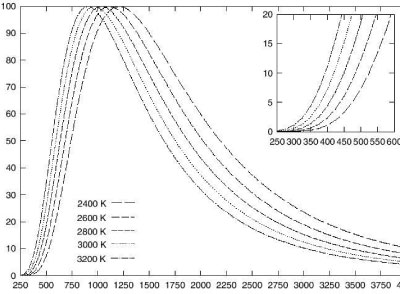 More information about incandescent lamps.
More information about incandescent lamps.
2. Gas discharge lamps.
When the lamp is turned on an electric discharge takes place and a current starts to flow through the vapor in the lamp; this causes the gas to heat up and it turns into a plasma (atoms lose a electron and the vapor becomes ionized). The plasma conducts the electric current, heats up and starts emitting light. Sometimes neon is used to startup the heating process in case of light sources based on metal vapors.
A historic overview and explanation of how such arc lamps work is presented here, through this link.
High or low pressure pressure mercury lamp In a mercury (Hg) lamp an arc goes through ionized mercury gas. At low pressure it shows the mercury atomic emission lines; at higher pressure the peaks become broader and a high pressure mercury lamp emits white (almost sun)light. Both high pressure and low pressure lamps are used in spectroscopy. For UV-Vis a high pressure lamp is needed because of the broad light spectrum it emits.
Spectral distribution of low pressure (left) and high pressure Hg lamp 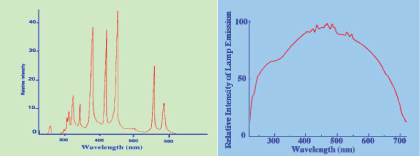
This link from the Edison Techcenter shows more details including how the mercury lamp works plus its history. A video on the mercury lamp (7min):
Deuterium lamp
A deuterium lamp is a gas discharge lamp and is often used as a UV source. It emits in general somewhere between the 160-450nm: Spectral distribution of a Deuterium lamp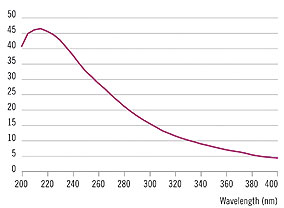
Xenon lamp
The xenon lamp is not often used in commercial UV/Vis-instruments.
In a Xenon lamp an arc is made through ionized xenon gas under high pressure. The high pressure gives the lamp high efficiency. It has a high intensity and the color is close to that of sunlight. More information through this link.
Spectral distribution of a xenon flash light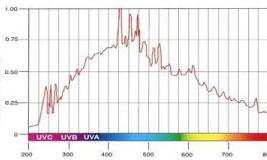 Figure.
Figure.
3. Light Emitting Diodes (LED)
A LED is a semi conductor which can emit light. LEDs can be used as a light source in the spectral region of 375-1000nm. Most LED are narrow banded (20-50 nm) but LEDs are cheap, have a long lifetimes and a small environmental impact.
Examples are:
- Gallium Aluminum Arsenide (900 nm)
- Gallium Aresenic Phosphide (650 nm)
- Gallium Nitride (465 nm)
- Indium Gallium Nitride (450nm)
- White LED: blue LED strikes phosphor (400-800 nm)
Additional informative and interesting material: A very nice website explaining how the different lamps work, their history and the components used in lamps can be found here.
Mary Kate: ch310 chapter 7comp of optical instruments. Slides 1-4 introduction Skoog(8ed) Chapter 25A-2 Spectroscopic Sources
A brief overview on light sources from the Colorado University. Comment: The wavelengths given for the light sources are not absolute. The light sources emit a distribution of different wavelengths. In short this means that light sources have an optimum wavelength and a region of wavelengths around the optimum for which they can be used. It does not mean that they do not emit other wavelengths. The optima and intensities of the sources can differ over their age.
Wavelength selectors
In spectroscopy, the sample either:- Absorbs light of some of the wavelenghts of a light source, as in Atomic Absorption (AA), UV-Vis absorption spectrometry and Infrared-spectroscopy (IR),
- Or emits a mixture of wavelengths, as in Atomic Emission Spectroscopy (AES) or the Inductively Coupled Plasma (ICP).
Three different types of wavelength selectors are used: diffraction gratings, prisms or colored filters. Nowadays in most instruments gratings are used because they perform much better: they have a broad wavelength range and can be tuned easily. These wavelength selectors are built into the monochromator of a spectrometer.
Diffraction grating A diffraction grating consists of a series of small parallel groves. These groves cause interference, which makes the grating split the light into different wavelengths. In a spectrometer in general reflective gratings are used.
Reflective grating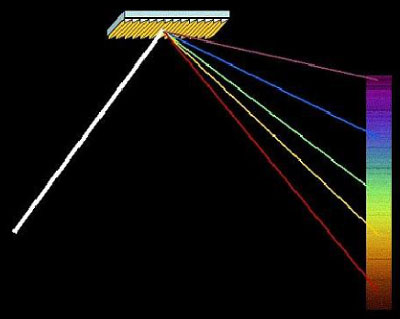
In a spectrometer usually a Czerny-Turner type monochromators is used. Such a monochromator is shown in the figure below, and consists of: B) an entrance slit C) and E) concave (hollow) mirror D) rotating reflective grating F) exit slit. A Czerny-Turner monochromator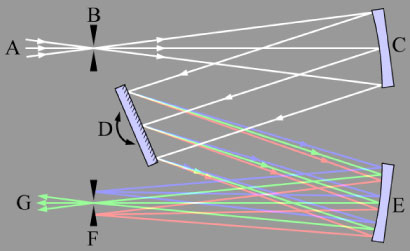
Rotating the grating makes different wavelengths pass the exit slit. More information about gratings through this link.
Prism
Different wavelengths have different refraction indices and therefore a prism can be used to disperse the light. A prism is a usually triangular shaped piece of glass or quarts that splits the light in its optical components. A prism disperses the white light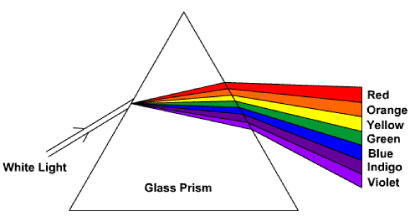 An experiment showing how a prism works in a spectrometer. The prism splits the light into its different colors:
An experiment showing how a prism works in a spectrometer. The prism splits the light into its different colors:
More information about prisms through this link.
Gratings vs Prisms, a comparison.
Filters
Filters are colored pieces of glass and can be used to select a specific wavelength range. They are not often used in UV-Vis spectrometry because they are not very practical: if we want to record an full spectrum we would need to replace these filters for every color we measure. The figure below shows what such filters look like. Bandpassfilters for various wavelengths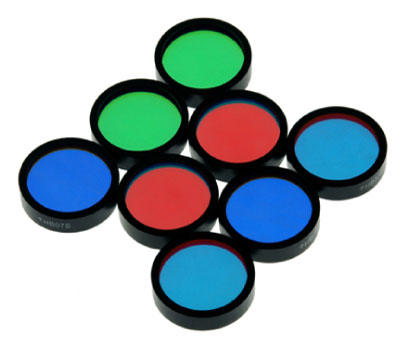
Mary Kate:
Chapter 7. Wavelength selectors
ch310 chapter 7comp of optical instruments. Slides 20-31 gratings
ch310 chapter 7comp of optical instruments. Slides 7-31 wavelengthselectors
Detectors
Detectors are based on the photoelectric effect, where a photon hits a surface with sufficient energy to release an electron from the material. A short very informative demonstration movie about the photoelectric effect (1m35s)
Figure: Photomultiplier tube 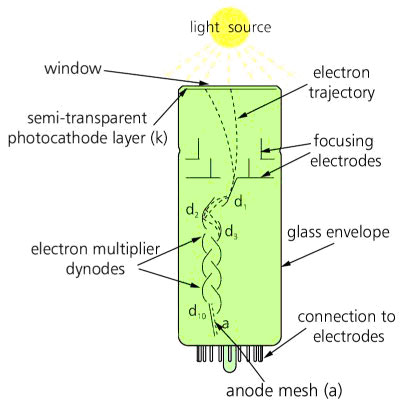
PMT – photomultiplier tube
The most common type of detector in a UV-Vis spectrophotometer is a photomultiplier tube (PMT). It consists of a photocathode which releases an electron when a photon reaches the material (the photoelectric effect). The multiplication effect is created by placing a series of electrodes to amplify the signal. The first electron released from the photocathode by a photon is accelerated by an electric field of around the 1000 Volts. Due to the increased kinetic energy caused by the electric field the electron can release more electrons when it hits the first dynode. The process of acceleration and release of more electrons by the following dynode is repeated for several times, causing a cascade of electrons which causes an electric signal at the anode. The intensity of that electric signal is a measure for the intensity of the light at the detector.
PDA – photodiode array
A photodiode array (PDA) consists of a row of photodiodes (in general 256, 512, 1024, or 2048 elements) which can record a full spectrum at once. Also a PDA which releases an electron when a photon reaches the material (the photoelectric effect). Figure: Diode Array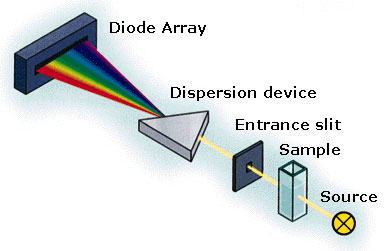
More details on photodiode and photomultiplier, this link.
CCD – charge coupled device
A charge coupled device (CCD) consists of row an area of photodiodes which releases an electron when a photon reaches the material (the photoelectric effect). A digital camera also uses a CCD to convert light into a signal. A CCD can record a full spectrum at once. More info.






